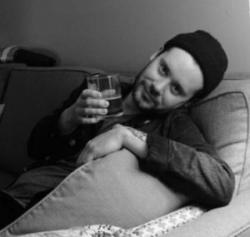One of Europe’s best known free jazz players mesmerizes old fans in Portland.
Peter Brötzmann’s Quartet took the stage at Mississippi Studios last Thursday night in silence, setting a powerful tone of what was to come, which I will say now, was something musically fierce. With no commentary or following encore, the band set off, led by the legendary free jazz saxophonist and clarinetist. Closing my eyes through the waving soundscapes, I found myself transported to a fictional world, one that was slowly decaying and being stripped away.
John Edwards vigorously played the upright bass, violin bow in hand, piercing the air with otherworldly sound textures. Like rapidly sped up seal calls from the Antarctic, it traveled the room, bouncing and warping my inner ear. He plucked away with immense speed, often hiding the bow between the strings. Jason Adasiewicz’s vibraphone added a freshness, not being the most traditional instrument in an avant-garde free jazz group.
Yells broke through the silence after nearly 15 minutes of Brötzmann inflating like a pufferfish.
While Brötzmann stepped aside to whittle his reed with a pocket knife from his right shirt pocket, the rhythms of Steve Noble on drums were mesmerizing; they seemed to waver off task momentarily. Brötzmann, standing stern and silent to the right of the stage, let the music swell before returning. I’ve seen him perform twice, and he’s always back on the drop of a dime, skipping straight to chaos without supplying us any glimpse of when his initiation would take place. The audience stayed quiet, waiting for the next epiphany to be presented to them, often struck by an evolution so quick it was hard to contain the excitement it evoked. Yells broke through the silence after nearly 15 minutes of Brötzmann inflating like a pufferfish.
This video is a few years old, but it shows Noble, Edwards and Brötzmann in London, 2012.
Born in Germany, Peter Brötzmann was first active in the mid 1960’s as a visual artist. He was prolific, having worked for the likes of Korean American artist Nam June Paik, believed to be the founder of video art. He also participated in the Fluxus Movement, an international collaboration of interdisciplinary artists, through the 1960’s and 70’s.
After growing tired of the group, but not necessarily leaving his roots behind, he started teaching himself to play multiple horn instruments and soon after, he began playing with ensembles. One of his highly regarded works of music is Machine Gun, recorded in 1968, which featured a plethora of talented individuals, one of whom was drummer and visual artist, Han Bennink.
I had the pleasure of seeing the two play together on April 8th, 2008 in the city of New Orleans, in my home state of Louisiana. It was in an especially small art space called The Big Top, directly off highway I-10. I clearly remember marijuana smoke billowing out of the green room as Brötzmann took the stage to join Han who was on the floor, playing his chair like a drum kit.
Now at the age of 75, I can’t help but think of the lung tolerance Brötzmann has built over a lifetime. While rarely coming up for air in a live setting, his bull-like figure charges on. He’s collaborated with Jazz greats — Anthony Braxton, Don Cherry, and Cecil Taylor — along with avant-garde composers and noise musicians such as John Zorn and Keiji Haino. I find it truly iconoclastic that he’s stayed so in tune with the music culture on over a hundred albums in the span of nearly fifty years. Drive and determination of a true artist gives us hope that maybe one day we can do the same, or in most cases, simply touch the surface.
Brötzmann’s mechanical presence is that of a sleek, unrelenting automatic weapon that just emptied a full round, as we stand paralyzed to open fire.
Back at the show, blue lights bounced off my shirt while simultaneously entering my field of vision as I looked upward. Streaks briefly blurred my eyes, people were only dark shadows lined up in perfect form until the silence reminded me where I was. The songs themselves were leaving me rooted by their repetitiveness, making it easy to retire to my thoughts. Switching back and forth from saxophone to clarinet gives his language just enough variety in tone and mood. The clarinet, being the softer of the two, elicits a gentle feeling, while his saxophone felt full of life; the swap always giving a boost in power. Brötzmann’s mechanical presence is that of a sleek, unrelenting automatic weapon that just emptied a full round, as we stand paralyzed to open fire.
I exited the venue conversing with friends about what it meant to each of us, and about the free structure of jazz, as opposed to a pop song that has hooks and verses. Brötzmann stirs up important questions and musical points, and he made us break down what music can mean in a less accessible way. He is continually collaborating, keeping a hold on creativity and consciousness. His legacy continues to provide us a deep understanding of ourselves on the path to enlightenment.


